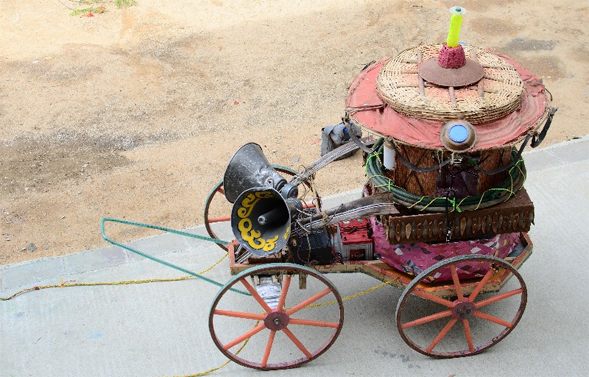Inspired by the Gods; Made by an Aztec
As a Fulbright Research Scholar in India, Aren Skalman created a modern version of the royal chariot of the gods.

It is said that travelers—not tourists, but bona fide adventure-seekers—leave something of themselves in the lands they visit.
Aren Skalman is living proof; he went to Bangalore, India, and left behind a work of art.
Skalman, who is working toward a master of arts in sculpture, was one of four SDSU students to win a Fulbright award for the 2012-2013 academic year. Twelve SDSU students received the award for 2013-2014 and are currently abroad.
Art as research
A graduate student of fine arts specializing in sculpture, Skalman had become interested in Indian art and music, learning to play a sitar-like instrument called the veena.
His application for a Fulbright Research Scholar award in India envisioned the creation and installation of a site-specific sculpture made from locally available materials. The sculpture would include a kinetic element and incorporate sound inspired by traditional Indian music.
“I had a general outline,” he said, “but the way I make art is a response to what I encounter," Skalman said. "My idea was to create an abstract artwork that reflected the location, history and people from a distinct point of view. This was a way of conducting research on art traditions and the current situation. Navigating the city and interacting as an artist was a very different way to experience and learn about a new place.”
In Bangalore, India’s booming technology hub, Skalman encountered a world of contradictions. People burn garbage outside modern glass skyscrapers. Tech millionaires on their way to work push past poverty stricken street kids. Transportation is difficult, particularly for pedestrians. The frenzied pace of the city influenced Skalman’s art.
“I had the idea for a mobile sculpture instead of a stationary piece, he said.”
A feast for the senses
Using commonplace materials from the city’s markets, Skalman began to construct a ratha, a spoke-wheeled vehicle modeled on chariots used by the gods in South Asian mythology.
His advisor at Karnataka Chitrakala Parishath School of Fine Arts, Tejendra Singh Baoni, who years earlier had been a Fulbright Scholar in Minnesota, introduced Skalman to student volunteers willing to help with his project.The work commenced.
"A typical day began by walking to the college, dodging auto-rickshaws, busses, motorcycles, and cars. Most days were spent working at school—a wonderful campus with a family of mischievous monkeys. I especially enjoyed creating alongside sculpture students, learning about their process, and exchanging ideas.
"With the help of friends I would take an auto-rickshaw or hop on the back of a motorcycle to visit the markets to negotiate for materials or have parts fabricated. One of my favorite spots was Bamboo Bazaar, where venders sold and made wood products of all kinds; small stalls with goats tied up, and stacked to the sky with bamboo, teak, or antique windows, doors and railings. I also spent a lot of time at City Market, a massive marketplace divided into districts where venders sold every type of product imaginable. These places were a feast for the senses."
Plastic brooms and seed pods
Dozens of the market's products found their way into Skalman's chariot, among them wood, welded steel, grass and plastic brooms, common kitchen goods, hoses collected from hardware stores, strips of vinyl sign material woven like palm fibers, seasonal seed pods fallen from trees and a variety of baubles.
Near the end of his stay, with the chariot complete, Skalman arranged a "culminating event." He and 10 friends pulled the chariot through the streets of Bangalore in a two-hour procession beginning at City Market and travelling for about three miles across busy intersections and through a number of neighborhoods.
"As the wheels turned, an arm struck cooking pots and pickle jars, making sounds while an original recorded track played simultaneously through metal speakers," Skalman recounted. "This was intended as an art 'performance,' but also as an intervention of walkers on the automobile filled roads. I was curious to know whether residents and commuters would see this as an artwork, religious activity, political action or some combination of those. The response and participation of people was extremely encouraging.
Living sculpture
Skalman lived in Bangalore for six months with his wife, Rebecca Bowman, and newborn son, James. During that time, the city was in the midst of constructing a rapid transit project.
The main stop, Mahatma Gandhi Road, features a newly renovated avenue called Rangoli Metro Art Centre. Here, travelers can stroll through gardens, peruse art galleries and watch artisans at work. Skalman’s sculpture is part of the “art walk,” and on weekends, center employees and parents take children to pull the chariot.
This semester, Skalman is back on campus, completing his graduate degree. He believes his months in India were especially fruitful because of his SDSU education.
"At SDSU, I learned how to communicate about art and think critically in a way that I had not known how to do before,” he said. “I have an openness to seeing art in everything, and that was cultivated here at San Diego State. I am especially grateful to the faculty in the fine arts areas, who have supported and mentored me in the application process, and who have challenged me to refine my practice.”



